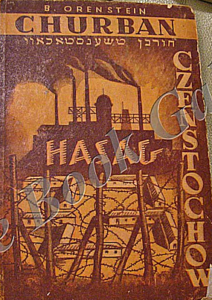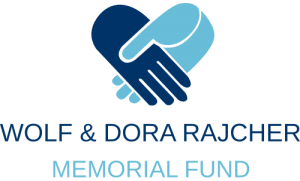Churban Czenstochow (1948)
"The Destruction of Częstochowa" - by Benjamin Orenstein
 This Yizkor Book was published, in 1948, by the Central Administration of the Częstochower Landsmannschaft in the American Zone in Germany. Being published so soon after World War Two, when memories of the horrors are still fresh, it provides us with even more insights into the destruction of Częstochowa Jewry.
This Yizkor Book was published, in 1948, by the Central Administration of the Częstochower Landsmannschaft in the American Zone in Germany. Being published so soon after World War Two, when memories of the horrors are still fresh, it provides us with even more insights into the destruction of Częstochowa Jewry.
As Dr Filip Friedman states in the book’s Foreword:
The author set himself the task of encompassing the tragedy of the Częstochowa Jews as comprehensively as possible. He described it in the tone of the pulsating Jewish life in Częstochowa prior to the War. ….
I am sure that Orenstein’s work introduces much new information with the abundance of materials that he has gathered, with his comprehensiveness and descriptions and his systematic and transparent composition of the historical material. …..
It is a work which constitutes an important contribution to the historical research of the era of destruction, and is concurrently a worthy and earnest memorial to the Jewish community of Częstochowa …
In his introduction to the book, Dr Cwi Kantor writes:
… the book has been published in the Latin script. [In] this, the Central Administration has taken into account the fact that – to our great regret – there is still a great part of the Jews in Germany and overseas for whom it is difficult or who are completely unable to read any quadrilateral Yiddish letters.
[Webmaster: There are two Yizkor Books written with the same title – “Churban Czenstochow” – one by Szlomo Waga and, this one, by Benjamin Orenstein. As far as we know, this is the FIRST PROFESSIONAL, English-language translation of this book.]
This Yizkor book has been PROFESSIONALLY translated into English,
for the FIRST TIME, in its entirety!
The professional English translation of this Częstochowa Yizkor book has been made possible by the financial support of the

Wolf Rajcher z”l and Dora Rajcher z”l were both Holocaust survivors from Częstochowa.
They were prisoners in both the “Big Ghetto” and the “Small Ghetto” and, until liberation, were slave labourers in HASAG-Pelcery. Following the War, they emigrated to Melbourne Australia.
Upon the passing of both his parents, their son, Andrew Rajcher, established this charitable fund in their memory.
Click on PART No. HEADINGS to reveal chapters.
Chapters are listed in the order in which they appear in the Yizkor Book.
(The numbers in brackets, after each article, correspond to the appropriate page numbers in the book.)
ENGLISH TRANSLATION:
Dave Horowitz-Larochette
IMPORTANT NOTICE
While this English translation is available for download, it may not, either in part or as a whole, be distributed or published without the prior written permission of Andrew Rajcher, this English-language version copyright-holder.
